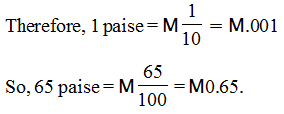- Books Name
- CBSE Class 6 Mathematics Book
- Publication
- Param Publication
- Course
- CBSE Class 6
- Subject
- Mathmatics
Comparing decimals
Decimal numbers may be compared by using the following steps :
Step I Obtain the decimal numbers.
Step II Compare the whole number parts of the numbers. The number with greater whole number part will be greater. If the whole number parts are equal, go to next step.
Step III Compare the extreme left digits of the decimal parts of two numbers. The number with greater extreme left digit will be greater. If the extreme left digits of decimal parts are equal, then compare the next digits and so on.
Ex.1 Which is greater of 48.23 and 39.35 ?
Sol. The given decimals have distinct whole number parts, so we compare whole number parts only.
In 48.23, the whole number part is 48.
In 39.35, the whole number part is 39.
∵48 > 39
∴ 48.23 > 39.35
Ex.2 Write the following decimals in ascending order :
5.64, 2.54, 3.05, 0.259 and 8.32
Sol Converting the given decimals into like decimals, we get :
5.640, 2.540, 3.050, 0.259 and 8.320
Clearly, 0.259 < 2.540 < 3.050 < 5.640 < 8.320
Hence, the given decimals in the ascending order are
0.259, 2.54, 3.05, 5.64 and 8.32
Using Decimals
Decimal properties can be used in variuos day to day examples
(1) Money
We know that 100 paise = M1

(2) Length : If we want to measure the length of the table in metres. We had a 50 cm scale.
We found that the length of the table top was 156 cm.

(3) Weight : We bought 500g potatoes, 250g capsicum, 700g onions, 500g tomatoes, 100g ginger and 300g radish. Then the total weight of the vegetables in the bag is given by
= 500 g + 250 g + 700 g + 500 g + 100 g + 300 g = 2350 g

 ReginaTagebücher
ReginaTagebücher
 Param Publication
Param Publication
